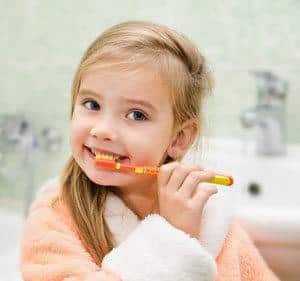General Dental Topics and Questions
What is a General Dentist for Children?
Dr. Chun is a general dentist focused on children’s dentistry. There are general dentists who have limited their practice to children’s dentistry and follow the best practices of the AAPD. They are qualified to perform children’s dentistry examinations and procedures. At Dental Kidz Club, we utilize both children’s dentistry, as well as general dentistry.
What’s The Best Toothpaste For My Child?

It’s easy to simply dollop a large amount of toothpaste on your child’s toothbrush and think “more must be better” but you may be surprised at the truth. A new study by the Centers for Disease Control shows that children are using too much toothpaste when they brush their teeth.
The American Dental Association recommends following these guidelines:
- Kids ages 2-3: rice grain-sized smear
- Kids age 3 and older: pea-sized amount
How Do Sealants Work?
Sealants work by filling in the areas on the surfaces of your child’s teeth. This stops food particles that can become caught in between teeth, causing cavities. Adding sealants is easy, comfortable and can protect your child’s teeth for many years.
Research has shown that dental sealants are safe, and they are effective. The American Dental Association recommends that dental sealants are an important step you should take to lower your risk of tooth decay and cavities. If you have any questions, talk to Dr. Chun.
When Can I Expect My Child’s Teeth To Come In?

By the time a baby is born, there are already 20 teeth underneath the gum line just waiting to burst through and cause of sorts of havoc! Below you’ll find what you can expect as a normal timeline for your babies incoming teeth.
Incisors
- At 6 to 10 months old, the lower central incisors (bottom front teeth) are expected.
- At 8 to 12 months old, the upper incisors are the next to appear.
- At 9 to 13 months old, the upper lateral incisors on each side of the front teeth arrive.
- At 10 to 16 months old, the lower lateral incisors appear.
Molars
- 12 to 19 months old, for the upper molars.
- 14 to 20 months old, for the lower first molars.
- 20 to 30 months old, the second pair of bottom molars start coming out.
- 25 to 33 months old, the upper second molars arrive.
Canines
- Appearing at 15 to 21 months old
- Appearing at 16 to 22 months old .
Does Your Child Grind His Teeth At Night? (Bruxism)
Parents are often concerned about the nocturnal grinding of teeth (bruxism). Often, the first indication is the noise created by the child grinding on their teeth during sleep. Or, the parent may notice wear (teeth getting shorter) to the dentition. One theory as to the cause involves a psychological component. Stress due to a new environment, divorce, changes at school; etc. can influence a child to grind their teeth. Another theory relates to pressure in the inner ear at night. If there are pressure changes (like in an airplane during take-off and landing, when people are chewing gum, etc. to equalize pressure) the child will grind by moving his jaw to relieve this pressure. The majority of cases of children’s bruxism do not require any treatment. If excessive wear of the teeth (attrition) is present, then a mouth guard (night guard) may be indicated. The negatives to a mouth guard are the possibility of choking if the appliance becomes dislodged during sleep and it may interfere with growth of the jaws. The positive is obvious by preventing wear to the primary dentition. The good news is most children outgrow bruxism. The grinding decreases between the ages 6-9 and children tend to stop grinding between ages 9-12. If you suspect bruxism, discuss this with your pediatrician or dentist.
Adult Teeth Coming in Behind Baby Teeth
This is a very common occurrence with children, usually the result of a lower, primary (baby) tooth not falling out when the permanent tooth is coming in. In most cases if the child starts wiggling the baby tooth, it will usually fall out on its own within two months. If it doesn’t, then contact your dentist, where they can easily remove the tooth. The permanent tooth should then slide into the proper place.

Thumb Sucking

Thumb sucking is a common habit among children. Many children stop sucking their thumbs on their own, often within the ages of 6-7 months or between ages 2-4 years old. But even a child who’s stopped sucking his or her thumb might go back to the behavior during times of stress. A few suggestions to help your child get through thumb sucking:
- Positive reinforcement. Praise your child or provide small rewards like an extra bedtime story or a visit to one their favorite playparks when they consistently stop sucking their thumbs. Set attainable goals, such as no thumb sucking an hour before bed or after lunch. Keep a record of the small victories – such as stickers on a calendar or fridge
- Identify triggers. If your child sucks his or her thumb in response to something specific, identify the real issue and provide other ways to cope – such as with a hug or reassuring words.
- Offer gentle reminders. If your child sucks his or her thumb without thought – rather than as a way to get attention – gently remind him or her to stop. Keep in mind not to scold, criticize or ridicule your child but instead provide loving assurance.
